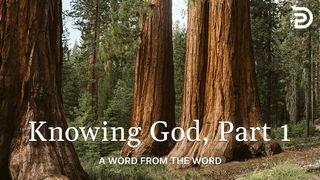The Heart Of Paul’s Theology: Paul And The ThessaloniansSample

Doctrine of Salvation in Thessalonians: 2 Thessalonians 2:13-14
Paul attempted to cool off the Thessalonians’ overheated eschatology by drawing their attention to dimensions of salvation in Christ they had largely ignored. Under the influence of false prophets, many Thessalonians had almost completely identified salvation with the blessings that will come with the return of Christ. Nothing else mattered except the salvation that would come at Christ’s return. To counter this overemphasis on the future, Paul pointed out that the salvation that will be applied when Christ returns depends upon the salvation that has already taken place. 2 Thessalonians 2:13-14 offer a helpful statement of the outlooks Paul wanted the Thessalonians to have.
Much could be said about these verses, but we will take note of three dimensions of salvation presented here. We will first see how Paul drew attention to salvation in the past, then we will turn our attention to his concern with future salvation, and finally we will explore how this passage touches on present or current dimensions of salvation. Let’s look first at the way Paul described salvation in the past.
With regard to past dimensions of salvation, Paul spoke of God’s choice, or election, of the Thessalonians. Paul said that God “chose” the Thessalonians, meaning that before the Thessalonians came to faith through Paul’s preaching of the gospel, God had already decided that he loved the Thessalonians and was going to save them. This choice was actually made even before God created the world. Consider how Paul talked about God’s election of people to salvation in Ephesians 1:4:
He chose us in [Christ], before the creation of the world, that we would be holy and blameless in his sight (Ephesians 1:4).
This idea seems to be present also in 2 Thessalonians 2:13, where Paul wrote:
God chose you from the beginning for salvation through the holiness of the Spirit and through belief in the truth (2 Thessalonians 2:13).
The Thessalonians’ conversion proved that God had already chosen them for salvation. By mentioning these past dimensions of salvation that had already been realized in the lives of the Thessalonians, Paul reaffirmed the gospel he had already preached to them, and assured them that they had already experienced certain aspects of salvation.
A second way Paul drew attention to salvation in his letters to the Thessalonians was by focusing on the future dimensions of their salvation. For example, in 1 Thessalonians 1:10 Paul wrote that believers are:
To await [God’s] Son from heaven, whom he raised from the dead —Jesus, the one who rescues us from the coming wrath (1 Thessalonians 1:10).
In much the same way, in 2 Thessalonians 2:14, he indicated that the ultimate end of divine redemption is:
Obtain[ing] the glory of our Lord Jesus Christ (2 Thessalonians 2:14).
In the third place, in addition to mentioning the past and future aspects of salvation, Paul also spoke of salvation as an ongoing, present reality. He mentioned this dimension of salvation in two ways in 2 Thessalonians 2:13.
God chose you to be saved through the sanctification of the Holy Spirit and through belief in the truth (2 Thessalonians 2:13).
On the one hand, Paul pointed out that salvation was coming to the Thessalonians “through the sanctification of the Spirit.” A great outpouring of the Holy Spirit among God’s people occurred when Christ ascended on high. And Paul pointed out that this was a blessing of the age to come. In fact, in Ephesians 1:14 he called the Holy Spirit the “down-payment” of our future inheritance in the great age to come. So, when he mentioned the Spirit at work in the Thessalonians, Paul drew their attention to the astounding fact that they were already experiencing a measure of the inheritance they so eagerly awaited.
Scripture
About this Plan

This reading plan investigates the background to Paul's letters to the Thessalonians, examines the structure and content of First and Second Thessalonians, and reveals his eschatology.
More
Related plans

Parenting Through God’s Lens: Seeing Your Child the Way God Does

Ruth: A Redeemer Who Fills All Emptiness | Video Devotional

Grace for Your Pace - How to Burn on Instead of Burn Out

An Encounter With Jesus

From Need to Maturity

The Generosity Practice

Overcoming Fear: A 5-Day Journey to Freedom, Faith, and the Father’s Embrace

Imposter Syndrome: You Are Who God Says You Are

A Word From the Word - Knowing God, Part 1
